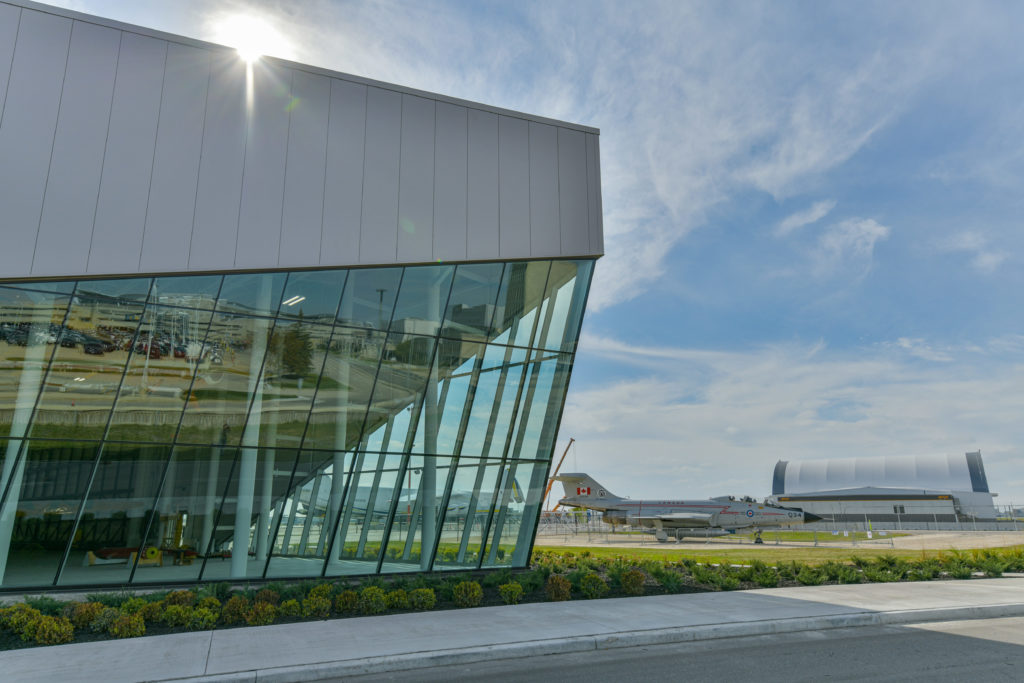Estimated reading time 8 minutes, 3 seconds.
The newly built Royal Aviation Museum of Western Canada held its grand opening on May 21, attracting more than 800 visitors to its new location at Winnipeg’s Richardson International Airport.
The museum has an extensive collection, so president Terry Slobodian can be forgiven for avoiding playing favorites. He noted that with more than 90 historic aircraft and 70,000 artifacts, photographs, and archival records, there is plenty for visitors to see. There is also an observation lounge where visitors can watch planes take off and land at CYWG.

The total space spans more than 86,000 square feet, or almost the size of a Canadian Football League field. The design of the new $27-million building features a two-storey section, with six aircraft suspended from the ceiling and many others on the floor.
“It’s an amazing, stunning building,” said Slobodian in an interview from Winnipeg. “As people drive by, they see aircraft through the windows on the hangar floor, as well as suspended from the ceiling. The other thing about our new museum is that it’s on four acres of land, and that means we can display aircraft outside, too.”
The museum’s former building on the site of the airport closed in October 2018. Construction on the new building on land leased from the Winnipeg Airports Authority began in May 2020. Two years later, the doors swung open to the public.
Plans call for one of the exhibits this summer to be a temporary tribute, in collaboration with the Gimli Glider Exhibit in Gimli, Manitoba — located roughly 90 kilometers (56 miles) north of Winnipeg.
“We have a temporary gallery within our museum to host various special exhibits, and one that we’re going to be featuring is an exhibit about the Gimli Glider,” said Slobodian.
In 1983, Air Canada Flight 143, also known as the Gimli Glider, ran out of fuel near the Ontario-Manitoba border en route to Edmonton. The plane’s captain, Robert Pearson, used a gliding technique known as sideslipping to guide the aircraft’s descent, landing safely in Gimli.
The temporary exhibit will feature video kiosks that display footage of the story surrounding the Gimli Glider.
Slobodian predicts that one of the most popular aircraft on display at the museum will be the Vickers Viscount turboprop. The museum’s Viscount, CF-THS, was based out of Trans-Canada Air Lines’ Winnipeg hangar. It served from 1958 to 1974. Volunteers revived the interior while Air Canada gave a new paint job to the plane.
“For a lot of people who are, let’s say, 55 years and older, they will say the Vickers Viscount is the first aircraft that they flew on,” said Slobodian.
On the military side, visitors will be able to see the restored Canadair CF-104 Starfighter 12703, an iconic Canadian-made aircraft known for its speed.
Another notable attraction will be a replica of the Vickers Vedette, a plane first deployed in the 1920s for photographic surveying for mapping purposes in northern Canada.
The institution’s roots date back to 1974, when the Western Canada Aviation Museum launched. In 2014, Queen Elizabeth awarded the coveted “Royal” designation.
“One of the key reasons that we were able to acquire the designation was the huge volunteer component of the museum,” said Bruce Emberley, the museum’s chairman.
The goal is to broaden the appeal for adults to ponder aviation’s past while also seeking to inspire the next generation. For example, the newly built museum has a kids’ zone for interactive play.

“We’re really working in close conjunction with the aviation-related industries in Manitoba, which are a big part of the local business community, to foster an awareness of aviation in kids,” said Emberley.
Professor of Indigenous studies at the University of Manitoba, Niigaan Sinclair, also worked closely with the museum to help develop some of the exhibits, as the new building is situated on Treaty 1 territory — the traditional lands of the Anishinaabeg, Cree, Oji-Cree, Dakota, Lakota, and Dene Peoples, and homeland of the Metis Nation.
“When you walk into the museum, there’s a land treaty acknowledgment,” noted Slobodian. “We commissioned an Indigenous artist, whose art will be right at the entrance.”
Overall, the new location is a vast improvement over the former site, which was “sort of hidden away down a little back street,” said Emberley. “Now, everybody who drives into or leaves the airport terminal in Winnipeg goes right by our front door.”
For Emberley, the Royal Aviation Museum of Western Canada is a family affair. His uncle, Gord Emberley, is among the museum’s five co-founders. Gord’s son, Doug, is also a co-founder, along with Murray Clearwater, Al Hansen, and Keith Olson.
Emberley was just a teenager when the aviation dream sprung to life nearly half a century ago. “My uncle and cousin had formed a group that looked for old aircraft parts, even before the museum started,” he said. “It has been almost a lifelong adventure since the early 1970s.”
The Royal Aviation Museum of Western Canada is open daily from 10 a.m. to 5 p.m.








